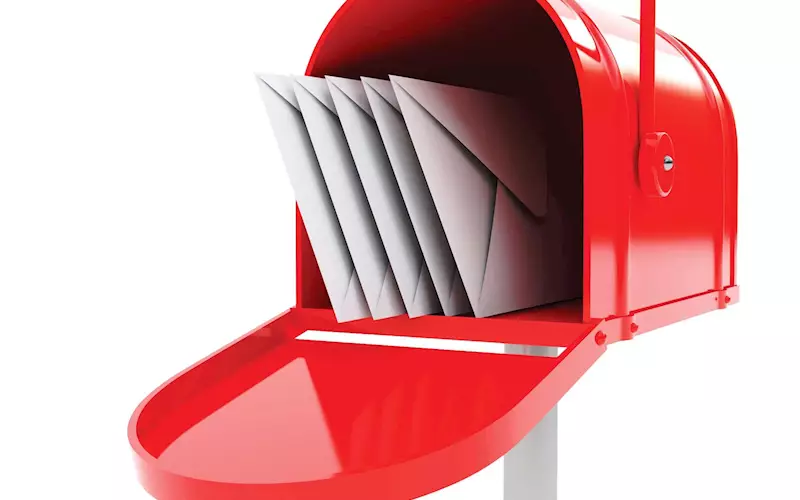Direct mail is in danger of being vanished from this country. Mismanagement and lack of interest from the government bodies has made mail’s future precarious, finds out PrintWeek India
The biggest issue in print today is turnaround and the unfathomable attitude about the potential of mail.
Prithviraj Desai, the director of Mumbai-based Mail Order Solution (MOS), says, “We have a client who does huge mailing campaigns every month to over five million customers located in 23 countries. All of these are personalised mailings printed in seven different languages.”
All the printing at MOS is done in-house, and the excellent data management enables mail preparation as per the norms of destination postal organisations.
“The campaigns are executed as per the mail date, and our client has benefitted significantly from our print, personalisation, data, and distribution services. The client has been able to successfully increase their return on investment by 25% by leveraging MOS’s strengths,” says Desai. For MOS, this has resulted in more mailings being produced per month, which has directly lead to successful penetration into newer markets and systematic acquisition of customers for the client.
In spite of these astonishing numbers, the humble mail is in danger of being diminished in the West due to mismanagement and a lack of political will. Volume is down by 30-40% and little is being done to realign the business with commercial realities.
Only recently, the chairman and the CEO of Australia Post publicly talking down mail with headlines announcing the end of mail. “You will not hear about the head of an airline company or a training company do this. But in the print industry we have people who are well paid to run the business, yet they will denigrate it. If a young marketing person in Australia reads the newspaper (or blog) and sees the head of Australia Post saying that “the humble mail” is finished, what are they going to promote to their clients? Mail would not rate a mention because even Australia Post has said it is all over for mail.”
So? What does the future look like?
In India, let us look at what is happening with India Post.
I think it is the most under-rated institution in our country. Today, India Post has around 1.4 lakh post offices in rural areas and handles savings deposits of Rs six-lakh crore rupees and postal insurance of over 40,000 crore rupees, which is just next to India’s largest bank, the state-run State Bank of India. It has already started connecting all its branches through internet and ATMs across the country.
Prithvitraj Desai, Mail Order Solutions
There is more
Six months ago, the Subramanian Committee on Leveraging the Post Office Network on 4 December 2014 submitted its report to the Union Ministry of Communications and Information Technology. The objective of the Committee was to transform the Post Office Network in keeping with changing market trends and competition.
The committee has made around 181 recommendations to make the post office competitive and efficient. These recommendations range from formulation of a New Postal Law to New Organisational design of India Post to Extension of Post Office network in rural areas.
Efficient mail

The recommendations of the Subramanium Committee is a good concept, but it only works if there is political will. The idea is to smooth out the peaks and troughs of mail volumes and allow for a more efficient processing system.
Also, there are ideas which are being practised elsewhere in the world like do we need daily delivery of mail and alternatively, could the public have mail delivered every second day? With every second day delivery, each Post Office could deliver mail to two areas, simply alternating each day. If the decline in transactional mail continues, then that would mean that the local postman will be delivering the same as he was eight years ago.
Again, we hear of stories about international postal legacies selling its mailing business. Or outsourcing their requirements. And then, investing millions into this business to compete directly with its clients. Fortunately they were not a particularly competent competitor. The tales of government department bureaucratic waste are legendary.
Asendia has an alliance with MOS Asendia is a Swiss government-owned service provider giving mailing companies the ability to print and deliver directly with the obvious cost savings. “As a result, customers mailing into multiple countries are able to execute their marketing programs using MOS’s high-volume, high-quality print capability and their distribution network to get mail delivered to their customers globally with quick turnaround time,” says Desai.
Mail at MOS
The work at MOS is very complex. Prithviraj Desai, states, “We have multiple personalised elements in one mail pack along with barcodes, etc. Hence, it was necessary for us to have a machine which was capable of collating and inserting variable elements without errors. It took us a long time to identify the right supplier for this. And finally, we decided to go with CMC and provided all the information we had. Creed Engineers was also a part of the process and they were all very supportive. It was a long drawn process which involved a lot of research, studying our work, and understanding current as well as future needs. We were going to invest in an inkjet along with an offline slitter from Hunkeler. The output from the inkjet would be huge, but if our collating and folding was going to be manual we would still have a problem. Hence the automation was needed. At the same time, we did not want to give up on the manual part as it allowed us flexibility. For the odd-sized jobs which we have, we would still need the manual collation and folding. Hence we opted for a combination of both.”

Desai continues, “With our manual collation and folding process, we were able to produce 1,50,000 mail packs every day in 2013-14. This means having a large number of people, which requires space. We could not have more people as to manage them and create space was an issue. With the CMC machine, we can produce another additional 150,000 plus the earlier 150,000 from the manual process. Hence, our post-press capacity per day has doubled to 300,000 mail packs. The 150,000 from CMC requires a team of four only per shift. So the automated system gives us efficiency, speed, and lower cost, whilst our earlier way gives us flexibility. Best of both worlds.”
KEY POINTS IN INDIA
1. Direct Mail and unaddressed mail is increasing in volume.
2. Transactional mail is declining.
3. A majority of the population lives in major cities.
4. Regional deliveries are expensive. This is a pain point. But also an opportunity.
5. Mail is no longer the only secure method of communication; therefore printers need to add value.
Opportunity

India’s population is concentrated in the capital cities of the 29 states and 7 union territories plus key regional cities.
With the world’s largest postal network, India Post has about 1.55 lakh post offices spread across the country. On an average, a post office serves an area of 21.21 sq/km and a population of 7,175 people.
The government is planning to utilise the huge resources at the disposal of India Post to provide cost-effective and innovative solutions to the citizens like financial services using digital connectivity, a source said.
The current government is very keen on digital mail boxes for government communications. No problem. Deregulate the market, allow new providers to only mail to and within the capital cities and major metropolitan areas.
“Mail is not the only way to communicate. We are working with legislation from a century ago. Mail is becoming less critical to the functioning of the government and country. We can move to deregulate the market as there are viable alternatives to communicate,” says Desai.
Having said that, mail does remain on balance the most trusted and effective way to communicate advertising material to a wide audience.
Any essential mail can be emailed or distributed through the digital mail boxes. If banks, advertisers or governments want to mail to regional areas – then they can pay for it.
Imagine if mail was only delivered to large areas in Jharkand or Chattisgarh? Or special schemes in Agartala and Kohima. The cost of a stamp would be under 35 paise. Desai explains, “We as a print community would be subsidising regional areas. I could offer my clients two options. Mail to 80% of your database at a low price and email the brochure to the other 20%.”
The government needs to look at the wider picture. You have a government monopoly that is inefficient with management that shows no sign of improving. The Indian print industry employs thousands of people generating billions of dollars in economic activity.
My argument is simple: less mail = less print = less employment = higher unemployment benefits and a lower tax take
Prithvitraj Desai, Mail Order Solutions
If the government was worried about the car industry and a few thousand workers – where is the concern over our industry?
The most important issue here is what happens next. Mail is one way to keep a great industry alive.
QUICK TIPS ABOUT MAIL
1. A mail printer must work on delivery standards.
2. Printers must maintain price without cutting costs. This is tough when volumes fall.
3. Employing senior management with a logistics background would be a good start.
4. Users – mail houses, printers and others –need to accept that service levels will change. If there are tangible benefits to our industry we need to assist with change, even if it adds costs to our businesses.
5. Data is key. One must be aware about the standardised address formats for different countries and how to handle data as per clients’ expectations.
6. Developed skill snad expertise in data handling operationsvis training sessions with consultants and focus on data security to win the clients' trust.
 The recommendations of the Subramanium Committee is a good concept, but it only works if there is political will. The idea is to smooth out the peaks and troughs of mail volumes and allow for a more efficient processing system.
The recommendations of the Subramanium Committee is a good concept, but it only works if there is political will. The idea is to smooth out the peaks and troughs of mail volumes and allow for a more efficient processing system.
 India’s population is concentrated in the capital cities of the 29 states and 7 union territories plus key regional cities.
India’s population is concentrated in the capital cities of the 29 states and 7 union territories plus key regional cities.













 See All
See All